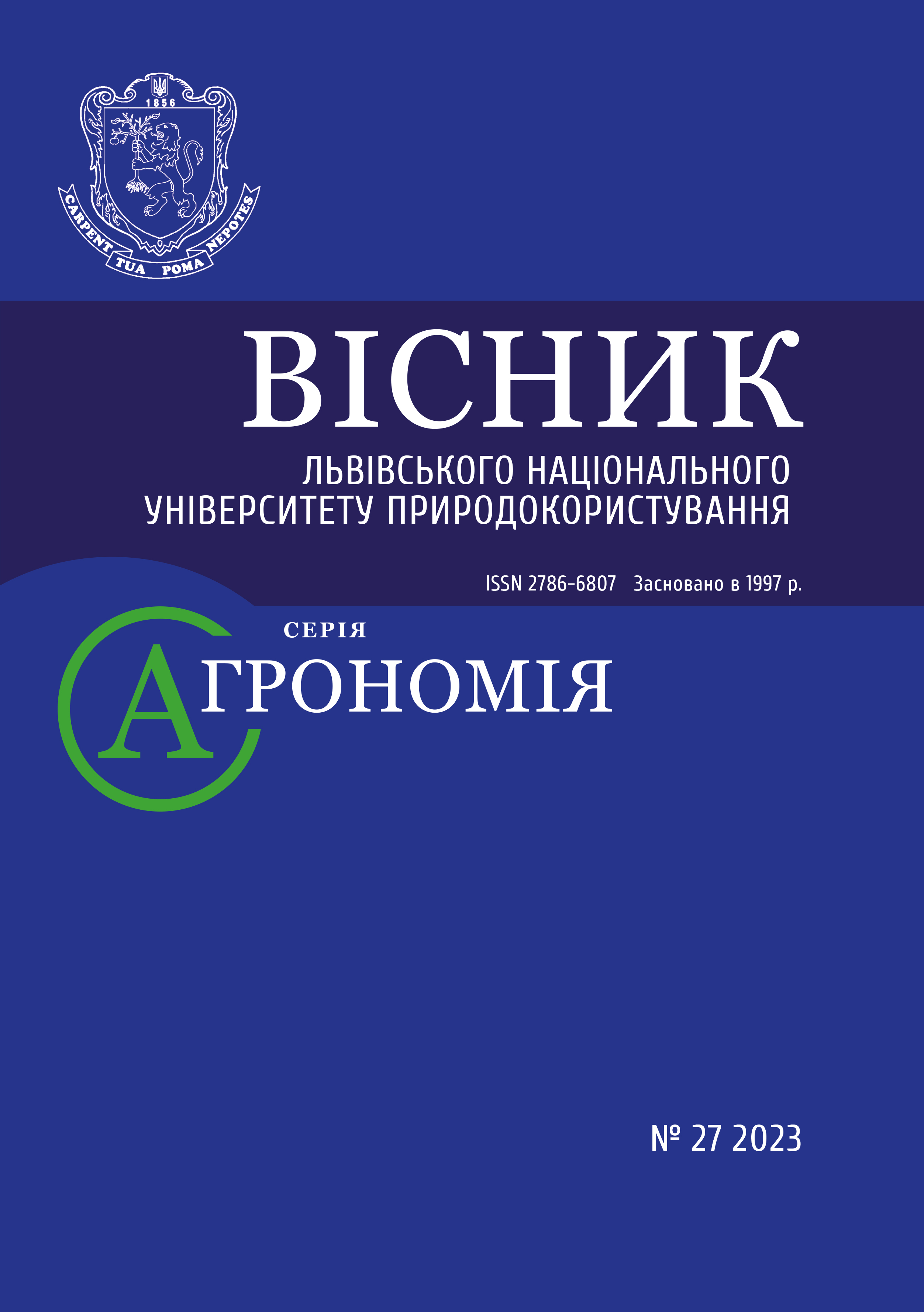THE EFFECT OF GIBBERELLIC ACID ON THE YIELD AND QUALITY OF ROOT PARSLEY (PETROSELINUM CRISPUM L.) IN CONDITIONS OF THE FOREST STEPPE OF UKRAINE
DOI:
https://doi.org/10.31734/agronomy2023.27.108Keywords:
parsley, yield, biochemical composition, plant treatment, gibberellic acid, root crop, rosette mass of leavesAbstract
Based on the results of the 2018–2020 research for the agro-climatic zone of the Left Bank Forest Steppe of Ukraine, a comprehensive study was conducted to determine the effect of the concentration of the phytohormone gibberellic acid on the yield and quality of root crops of parsley (Petroselinum crispum L.) samples and the most effective concentrations of the substance were selected. It was proved that both gibberellic acid in different concentrations of the active substance and the agroclimatic conditions of the experimental field affected the yield of root crops of root parsley. The use of gibberellic acid made it possible to reduce the yield of non-marketable root crops to 0.9–2.4 t/ha. The amount of marketable products within the scope of the experiment was at the level of 27.6–35.7 t/ha. Higher values are indicated in variants with the use of gibberellic acid. Spraying plants with the acid during the growing season provided an increase in the diameter of the parsley root head to the level of 3.5–5.0 cm. The length of the root crops in the experiment was 15.6–19.4 cm and also greater than when using growth regulators. The results of the analysis of the biochemical composition of root crops of root parsley proved that growth regulators changed the content of dry matter, total sugar, vitamin C and nitrates. In terms of dry matter content, the advantage was noted in variants with two-time spraying of plants with gibberellic acid solution, in which the dry matter content was 2.6–3.9 % higher compared to the control. It should be noted that spraying root parsley plants with a solution of gibberellic acid helped to reduce the nitrate content in root crops, in particular, in the variants with the use of a growth regulator, the nitrate content was 81–159 mg/kg less compared to the control variant.
References
Anishyn L. A., Ponomarenko S. P., Hrytsaienko Z. M. Plant growth regulators. Recommendations for use. Kyiv, 2011. 40 p.
Barabash O. Yu., Syrotin M. F., Rubtsov M. P. Table roots. Kyiv: Urozhai, 1987. 136 p.
Bondarenko H. L. Methodology of experimental work in vegetable growing and melon growing. Kharkiv: Basis, 2001. 369 p.
Han Yan, Zhaokai Yang, Shunhong Chen, Jian Wu, Exploration and development of artificially synthesized plant growth regulators, Advanced Agrochem, 2023. https://doi.org/10.1016.
Hrytsaenko Z. M., Ponomarenko S. P., Karpenko V. P., Leontyuk I. B. Biologically active substances in crop production. Kyiv: CJSC «NICHLAVA», 2008. 352 p.
Kalinin F. A. Application of growth regulators in agriculture. Kyiv: Harvest, 1989. 66 p.
Kondratenko S. I. Effect of plant extract and new synthetical substitutes of phytohormones on plant regeneration from protoplasts of cabbage (Brassica oleracea var. capitata). Lithuanian journal of horticulture and vegetable growing. 2001. Vol. 20 (3), No 1. P. 343–349.
Kondratenko S. I. Production of somatic hybrids between different cultivars of cabbage (Brassica oleracea var. capitata). Lithuanian journal of horticulture and vegetable growing. 2001. Vol. 20 (3), No 1. P. 350–358.
Kuryata V. G., Golunova L. A. Peculiarities of the formation and functioning of soybean-rhizobial complexes and the productivity of soybean culture under the influence of the retardant of paclobutrazol. Ukrainian Journal of Ecology. 2018. No 8 (3). P. 98–105.
Musatenko L. I. Phytohormones and physiologically active substances in the regulation of plant growth and development. Physiology of plants: problems and prospects of development: Ф 50 at 2t/NAS of Ukraine, Institute of Plant Physiology and Genetics, Ukrainian Society of Plant Physiologists. Kyiv: Logos, 2009. Р. 508–536.
Nikolaichuk V. I., Heinyk L. V., Horbatenko I. Yu. Study of the action of ethylene produceretprole, which regulates the growth and development of plants. Physiology and biochemistry of plant culture. 1999. Vol. 31, No 4. P. 281–284.
Ponomarenko S. P. Plant growth regulators based on N-oxides of pyridine derivatives (physico-chemical properties and biological activity). Kyiv: Tech, 1999. 272 p.
Ponomarenko S. P. Ukrainian regulators of plant growth. Coll. of science works Kyiv: Compass, 1998. 36 p.
Yusu Cheng, Mingxuan Li, Pei Xu, Allelochemicals: A source for developing economically and environmentally friendly plant growth regulators. Biochemical and Biophysical Research Communications. 2024. Vol. 690. 149248. https://doi.org/10.1016/j.bbrc. 2023. P. 149–248.
Zhang Yi, LIU Yun-Li, LIU Zi-Sen, HAN Fan, YAN Pan, HE Feng, WU Zhen-Bin. The research application progress of plant growth regulators. [J]. ACTA HYDROBIOLOGICA SINICA. 2021. No 45 (3). P. 700–708. doi:10.7541/2021.2019.035.


